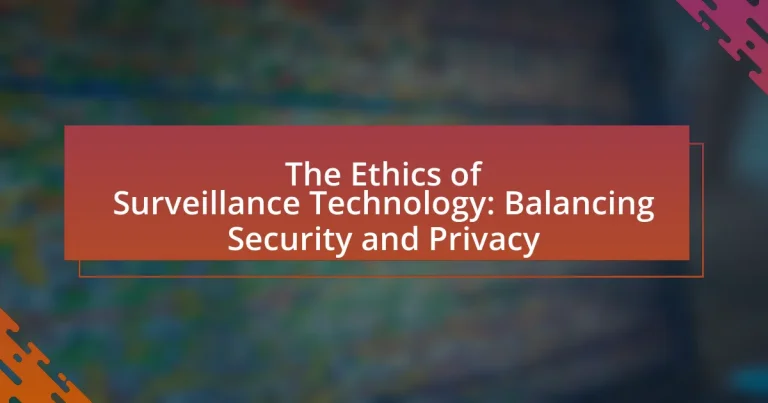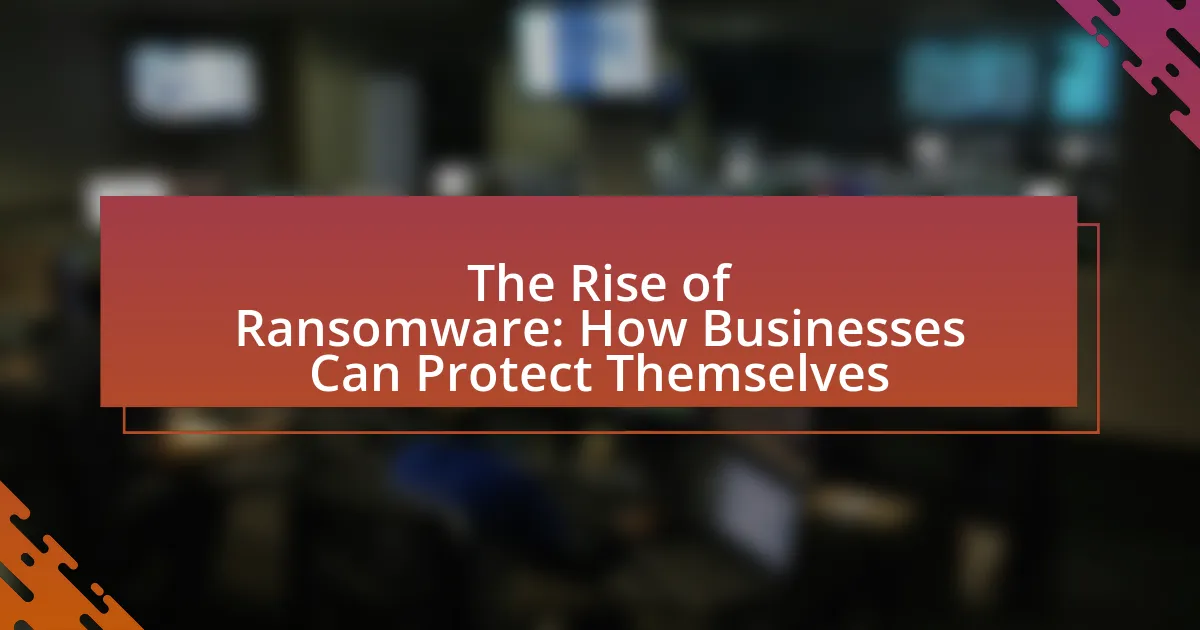The article examines the ethical implications of surveillance technology, focusing on the tension between security needs and individual privacy rights. It highlights concerns regarding privacy invasion, consent, and the potential for abuse of power, emphasizing the necessity for stringent regulations and ethical guidelines. Key topics include the impact of surveillance on personal privacy, risks to data security, public trust, and the role of government in regulating surveillance practices. The article also explores various surveillance technologies, the importance of consent, and strategies for individuals to protect their privacy in a surveillance-heavy society, while discussing future trends and innovations that could enhance privacy alongside security.
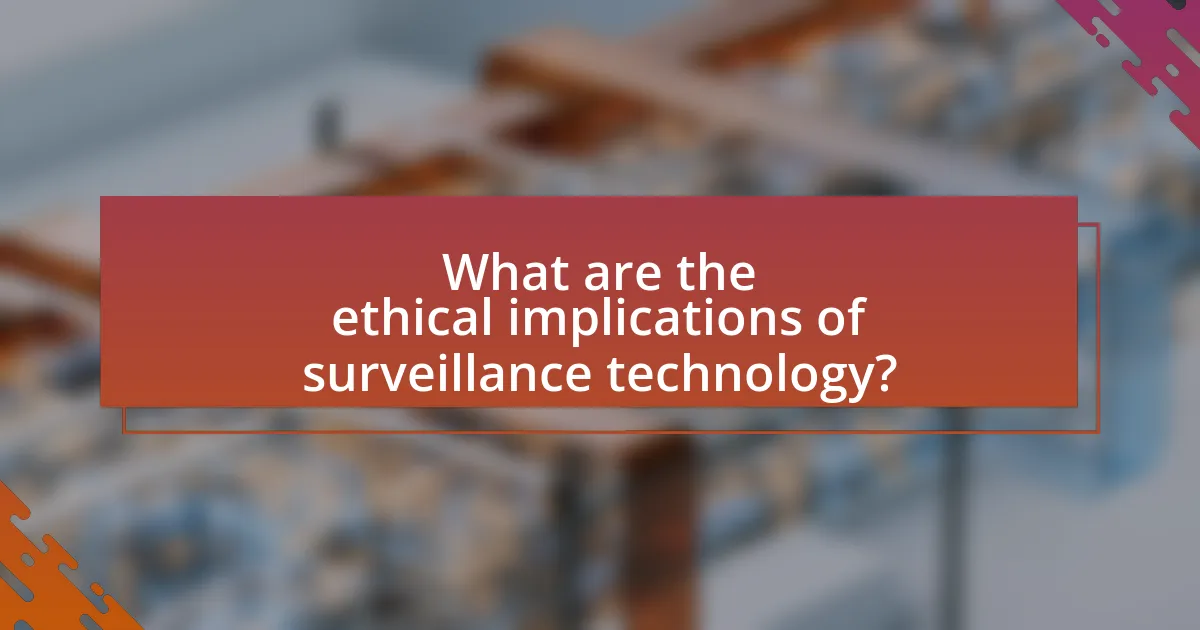
What are the ethical implications of surveillance technology?
The ethical implications of surveillance technology primarily revolve around privacy invasion, consent, and the potential for abuse of power. Surveillance technology often collects personal data without explicit consent, leading to violations of individual privacy rights. For instance, a 2020 study by the Electronic Frontier Foundation highlighted that 79% of Americans expressed concern about government surveillance infringing on their privacy. Additionally, the potential for misuse by authorities raises significant ethical concerns, as seen in cases where surveillance data has been used for discriminatory practices or unjust profiling. These factors underscore the need for stringent regulations and ethical guidelines to ensure that surveillance technology is employed responsibly, balancing security needs with the protection of individual rights.
How does surveillance technology impact individual privacy?
Surveillance technology significantly impacts individual privacy by enabling the collection and analysis of personal data without consent. This technology, including CCTV cameras, facial recognition systems, and online tracking, allows governments and corporations to monitor individuals’ activities, often infringing on their right to privacy. For instance, a report by the Electronic Frontier Foundation highlights that facial recognition technology can identify individuals in public spaces, leading to potential misuse and profiling. Furthermore, a study published in the Journal of Privacy and Confidentiality indicates that pervasive surveillance can create a chilling effect, discouraging free expression and assembly. These examples illustrate how surveillance technology can erode personal privacy and alter societal behavior.
What are the potential risks to personal data security?
The potential risks to personal data security include unauthorized access, data breaches, and identity theft. Unauthorized access occurs when individuals exploit vulnerabilities in systems to gain confidential information. Data breaches, which affected over 37 billion records in 2020 alone, can result from cyberattacks or inadequate security measures. Identity theft involves the misuse of personal information to commit fraud, impacting millions annually, with the Federal Trade Commission reporting over 1.4 million identity theft cases in 2020. These risks highlight the critical need for robust security protocols to protect personal data.
How do surveillance practices affect public trust?
Surveillance practices negatively affect public trust by creating perceptions of invasion of privacy and government overreach. Studies indicate that when individuals believe they are being monitored, their sense of autonomy diminishes, leading to increased skepticism towards authorities. For instance, a 2018 survey by the Pew Research Center found that 81% of Americans feel that the potential risks of surveillance by the government outweigh the benefits. This erosion of trust can result in decreased cooperation with law enforcement and a reluctance to engage with public institutions, ultimately undermining the social contract between citizens and the state.
What role does government play in regulating surveillance technology?
The government plays a crucial role in regulating surveillance technology by establishing laws and guidelines that govern its use to protect citizens’ privacy rights while ensuring national security. This regulation often includes creating legal frameworks that dictate how surveillance data can be collected, stored, and used, as seen in legislation like the USA PATRIOT Act and the General Data Protection Regulation (GDPR) in Europe. These laws aim to balance the need for security measures with the protection of individual privacy, reflecting societal values and ethical considerations surrounding surveillance practices.
What laws exist to protect citizens from invasive surveillance?
Laws that protect citizens from invasive surveillance include the Fourth Amendment to the United States Constitution, which guards against unreasonable searches and seizures, requiring law enforcement to obtain warrants based on probable cause. Additionally, the Electronic Communications Privacy Act (ECPA) regulates government access to electronic communications and data, ensuring that individuals have a degree of privacy in their digital communications. The Foreign Intelligence Surveillance Act (FISA) also imposes restrictions on surveillance activities conducted for national security purposes, mandating oversight by the Foreign Intelligence Surveillance Court. These laws collectively establish a legal framework aimed at safeguarding individual privacy rights against intrusive surveillance practices.
How do different countries approach surveillance ethics?
Different countries approach surveillance ethics through varying legal frameworks and cultural perspectives. For instance, the United States emphasizes national security and law enforcement needs, often prioritizing surveillance capabilities, as seen in the USA PATRIOT Act, which expanded government surveillance powers post-9/11. In contrast, European countries, particularly those within the European Union, adhere to stricter privacy regulations, such as the General Data Protection Regulation (GDPR), which mandates transparency and consent for data collection. Additionally, countries like Germany, with a history of state surveillance abuses, maintain robust protections against intrusive surveillance practices, reflecting a societal commitment to privacy. These differing approaches highlight the balance each nation seeks between security and individual privacy rights, influenced by historical context and public sentiment.
Why is there a need for a balance between security and privacy?
A balance between security and privacy is essential to protect individual rights while ensuring public safety. Excessive security measures can infringe on personal freedoms and lead to a surveillance state, undermining trust in government and institutions. Conversely, inadequate security can expose individuals and communities to threats, such as terrorism or crime. For instance, the 9/11 attacks highlighted the need for enhanced security measures, yet subsequent debates emphasized the importance of maintaining civil liberties, as seen in the backlash against the USA PATRIOT Act. Thus, achieving a balance is crucial for fostering a safe society that respects personal privacy rights.
What are the arguments for increased surveillance in the name of security?
Increased surveillance in the name of security is argued to enhance public safety by deterring crime and enabling quicker responses to threats. Proponents assert that surveillance technologies, such as CCTV and data monitoring, can reduce criminal activity by creating a sense of being watched, which studies have shown can lead to lower crime rates in monitored areas. Additionally, surveillance aids law enforcement in investigating and solving crimes more efficiently, as evidenced by the use of video footage in criminal cases that has led to successful prosecutions. Furthermore, in the context of national security, increased surveillance is justified as a means to prevent terrorism and other threats, with governments citing instances where surveillance has thwarted planned attacks.
How can privacy rights be upheld in a surveillance-heavy society?
Privacy rights can be upheld in a surveillance-heavy society through robust legal frameworks, transparency in surveillance practices, and the implementation of privacy-enhancing technologies. Legal frameworks, such as the General Data Protection Regulation (GDPR) in Europe, establish clear guidelines for data collection and usage, ensuring individuals have rights over their personal information. Transparency is crucial; governments and organizations must disclose surveillance methods and data usage to foster public trust and accountability. Additionally, privacy-enhancing technologies, like encryption and anonymization tools, empower individuals to protect their data from unauthorized access. These measures collectively create an environment where privacy rights are respected and maintained despite pervasive surveillance.
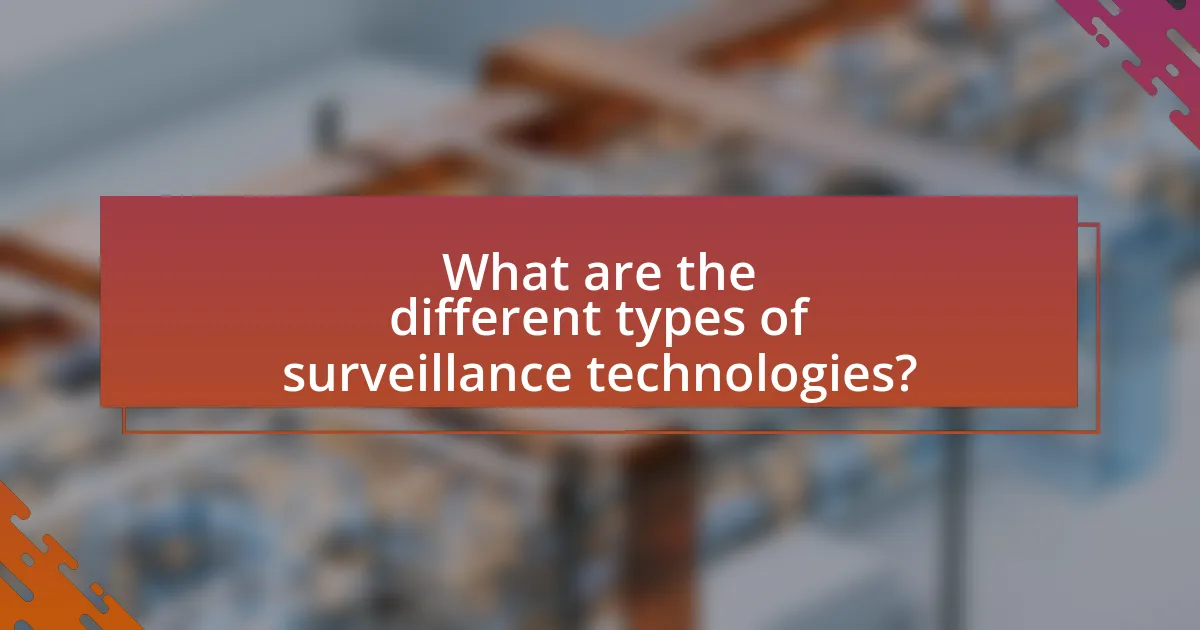
What are the different types of surveillance technologies?
The different types of surveillance technologies include closed-circuit television (CCTV), drones, biometric systems, GPS tracking, and internet monitoring tools. CCTV systems are widely used for real-time video surveillance in public and private spaces, providing visual monitoring capabilities. Drones equipped with cameras can capture aerial footage for surveillance purposes, often used in law enforcement and border control. Biometric systems utilize unique physical characteristics, such as fingerprints or facial recognition, to identify individuals, enhancing security measures. GPS tracking technology allows for the monitoring of vehicle movements and personal location tracking, often employed in fleet management and personal safety applications. Internet monitoring tools analyze online activities, including social media and web browsing, to gather data for security and marketing purposes. Each of these technologies plays a significant role in surveillance practices, reflecting the ongoing balance between security needs and privacy concerns.
How do video surveillance systems function?
Video surveillance systems function by capturing real-time video footage through cameras, which then transmit this data to a recording device or a cloud-based storage system. The cameras can be analog or digital, with digital systems often providing higher resolution and remote access capabilities. The recorded footage can be monitored live or reviewed later, enabling security personnel to detect and respond to incidents. According to a report by the Security Industry Association, the global video surveillance market was valued at approximately $42 billion in 2020, indicating the widespread adoption and reliance on these systems for security purposes.
What are the common uses of CCTV in public spaces?
CCTV is commonly used in public spaces for surveillance, crime prevention, traffic monitoring, and public safety. These systems help deter criminal activity by providing a visible security presence, which can reduce incidents of theft and vandalism. For instance, studies have shown that areas with CCTV installations experience a significant decrease in crime rates, with some reports indicating reductions of up to 25%. Additionally, CCTV aids in monitoring traffic flow and accidents, allowing for quicker responses from emergency services. Public safety is enhanced as CCTV can assist in crowd management during events, ensuring a safer environment for attendees.
How does facial recognition technology work?
Facial recognition technology works by analyzing and identifying human faces through a series of algorithms that map facial features. The process begins with capturing an image of a face, which is then converted into a digital representation. This representation is compared against a database of known faces using techniques such as feature extraction and machine learning algorithms. For instance, the technology often utilizes landmarks on the face, such as the distance between the eyes or the shape of the jawline, to create a unique facial signature. Studies indicate that modern facial recognition systems can achieve accuracy rates exceeding 99% under optimal conditions, demonstrating their effectiveness in identifying individuals.
What are the implications of data collection through mobile devices?
Data collection through mobile devices has significant implications for privacy and security. The pervasive nature of mobile technology allows for the continuous gathering of personal data, which can lead to unauthorized surveillance and breaches of individual privacy. For instance, a study by the Pew Research Center found that 79% of Americans are concerned about how their data is being used by companies, highlighting widespread apprehension regarding data misuse. Additionally, the potential for data to be exploited by malicious actors increases the risk of identity theft and fraud. These implications necessitate a careful balance between leveraging data for security purposes and protecting individual privacy rights.
How do location tracking services impact user privacy?
Location tracking services significantly impact user privacy by collecting and storing sensitive geographical data without explicit consent. These services can reveal personal habits, routines, and locations, leading to potential misuse of information by third parties. For instance, a study by the Electronic Frontier Foundation highlights that many apps track users’ locations even when not in use, raising concerns about unauthorized surveillance. Furthermore, data breaches can expose this information, compromising user safety and privacy. Thus, while location tracking can enhance services, it poses substantial risks to individual privacy rights.
What are the risks associated with biometric data collection?
Biometric data collection poses several risks, including privacy violations, data breaches, and potential misuse of information. Privacy violations occur when individuals are unaware that their biometric data is being collected or used, leading to a lack of consent. Data breaches can expose sensitive biometric information, which is often irreversible, as biometric traits cannot be changed like passwords. Furthermore, the misuse of biometric data can lead to discrimination, profiling, or unauthorized surveillance, undermining civil liberties. A study by the Electronic Frontier Foundation highlights that once biometric data is compromised, it can be exploited for identity theft or unauthorized access, emphasizing the critical need for stringent data protection measures.
What emerging surveillance technologies should we be aware of?
Emerging surveillance technologies to be aware of include facial recognition systems, drone surveillance, and artificial intelligence-driven analytics. Facial recognition technology has advanced significantly, with systems capable of identifying individuals in real-time across various environments, raising concerns about privacy and misuse. Drone surveillance has become more prevalent, allowing for aerial monitoring of large areas, which can be both beneficial for security and invasive to personal privacy. Additionally, artificial intelligence is increasingly used to analyze vast amounts of data from various sources, enabling predictive policing and behavior analysis, which can lead to ethical dilemmas regarding civil liberties and discrimination. These technologies are rapidly evolving, necessitating ongoing discussions about their implications for privacy and security.
How might artificial intelligence change the landscape of surveillance?
Artificial intelligence will significantly transform the landscape of surveillance by enhancing data analysis capabilities and automating monitoring processes. AI algorithms can process vast amounts of data from various sources, such as cameras and sensors, in real-time, allowing for quicker identification of suspicious activities. For instance, facial recognition technology, powered by AI, has been shown to improve identification accuracy, with some systems achieving over 99% accuracy in controlled environments. This capability can lead to more effective crime prevention and response strategies. However, the increased efficiency of AI in surveillance raises ethical concerns regarding privacy and civil liberties, as the potential for mass surveillance and misuse of data becomes more pronounced.
What ethical concerns arise from the use of drones in surveillance?
The ethical concerns arising from the use of drones in surveillance primarily include privacy violations, potential misuse of data, and lack of accountability. Privacy violations occur as drones can capture images and data without individuals’ consent, infringing on personal privacy rights. The potential misuse of data is significant, as surveillance footage can be exploited for purposes beyond security, such as profiling or discrimination. Additionally, the lack of accountability in drone operations raises concerns about oversight and regulation, leading to possible abuses of power by authorities. These issues highlight the need for clear ethical guidelines and legal frameworks to govern drone surveillance practices.
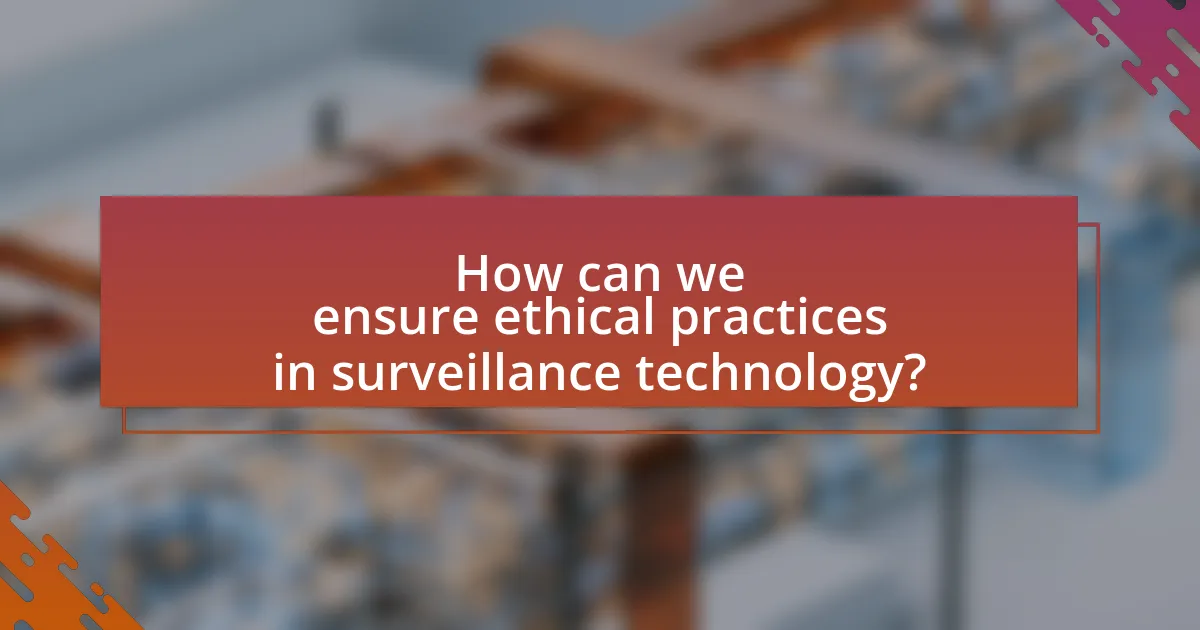
How can we ensure ethical practices in surveillance technology?
To ensure ethical practices in surveillance technology, it is essential to implement strict regulatory frameworks that govern its use. These regulations should include clear guidelines on data collection, storage, and sharing, ensuring transparency and accountability. For instance, the General Data Protection Regulation (GDPR) in the European Union mandates that individuals have the right to know how their data is used, which promotes ethical standards in surveillance practices. Additionally, regular audits and assessments of surveillance systems can help identify and mitigate potential abuses, reinforcing ethical compliance.
What best practices should organizations follow when implementing surveillance systems?
Organizations should follow best practices such as conducting a thorough risk assessment, ensuring transparency, and adhering to legal regulations when implementing surveillance systems. A comprehensive risk assessment identifies potential privacy concerns and security vulnerabilities, allowing organizations to address them proactively. Transparency involves informing employees and the public about the surveillance measures in place, fostering trust and accountability. Adhering to legal regulations, such as the General Data Protection Regulation (GDPR) in Europe, ensures that organizations respect individuals’ privacy rights and avoid legal repercussions. These practices collectively enhance the ethical deployment of surveillance technology while balancing security needs with privacy considerations.
How can transparency be maintained in surveillance operations?
Transparency in surveillance operations can be maintained through clear policies, regular audits, and public reporting. Establishing comprehensive guidelines that outline the purpose, scope, and limitations of surveillance activities ensures accountability. Regular audits by independent bodies can verify compliance with these guidelines, while public reporting on surveillance practices fosters trust and informs citizens about how their data is being used. For instance, the implementation of the General Data Protection Regulation (GDPR) in the European Union mandates transparency in data processing activities, requiring organizations to disclose their surveillance practices to individuals. This regulatory framework exemplifies how legal requirements can enhance transparency in surveillance operations.
What role does consent play in ethical surveillance practices?
Consent is fundamental in ethical surveillance practices as it establishes the legitimacy of data collection and usage. When individuals provide informed consent, they acknowledge their awareness of surveillance activities and agree to the terms under which their data will be collected and processed. This principle is supported by legal frameworks such as the General Data Protection Regulation (GDPR), which mandates that consent must be explicit, informed, and revocable. Ethical surveillance practices prioritize consent to respect individual autonomy and privacy rights, ensuring that surveillance does not infringe upon personal freedoms without accountability.
How can individuals protect their privacy in a surveillance society?
Individuals can protect their privacy in a surveillance society by utilizing encryption tools, employing privacy-focused technologies, and being mindful of their digital footprints. Encryption tools, such as Signal for messaging and VPNs for internet browsing, secure communications and mask online activities from surveillance. Privacy-focused technologies, like browsers with built-in ad blockers and tracking protection, help limit data collection. Additionally, individuals should regularly review privacy settings on social media platforms and limit the sharing of personal information, as studies show that over 70% of users unknowingly expose sensitive data online. By adopting these practices, individuals can significantly reduce their vulnerability to surveillance.
What tools and strategies can help safeguard personal information?
To safeguard personal information, individuals can utilize tools such as password managers, encryption software, and virtual private networks (VPNs). Password managers securely store and generate complex passwords, reducing the risk of unauthorized access; for instance, a study by the National Cyber Security Centre found that 81% of data breaches are linked to weak passwords. Encryption software protects sensitive data by converting it into a secure format, making it unreadable without the correct decryption key. VPNs enhance online privacy by masking IP addresses and encrypting internet traffic, which is crucial in preventing data interception, as highlighted by research from the Electronic Frontier Foundation indicating that VPNs can significantly reduce the risk of surveillance and data theft.
How can public awareness campaigns influence surveillance ethics?
Public awareness campaigns can significantly influence surveillance ethics by educating the public about privacy rights and the implications of surveillance technologies. These campaigns raise awareness of potential abuses and ethical dilemmas associated with surveillance, prompting public discourse and policy changes. For instance, the “Stop Watching Us” campaign in the United States mobilized citizens against government surveillance practices revealed by whistleblowers, leading to increased scrutiny and calls for reform in surveillance laws. Such campaigns can shift societal norms and expectations regarding privacy, ultimately guiding ethical standards in surveillance practices.
What are the future trends in surveillance technology ethics?
Future trends in surveillance technology ethics will increasingly focus on transparency, accountability, and the protection of individual privacy rights. As surveillance technologies evolve, there is a growing demand for clear regulations that govern their use, ensuring that citizens are informed about how their data is collected and utilized. For instance, the implementation of privacy-by-design principles in technology development is becoming more prevalent, requiring companies to integrate ethical considerations from the outset. Additionally, public discourse around surveillance practices is intensifying, leading to greater advocacy for ethical frameworks that prioritize human rights. Reports from organizations like the Electronic Frontier Foundation highlight the necessity for robust oversight mechanisms to prevent abuse and ensure compliance with ethical standards.
How might public opinion shape the future of surveillance regulations?
Public opinion significantly influences the future of surveillance regulations by shaping policymakers’ decisions and legislative actions. When a substantial portion of the public expresses concern over privacy violations or the misuse of surveillance technologies, lawmakers are more likely to respond with stricter regulations to address these concerns. For instance, the backlash against the NSA’s mass surveillance practices revealed through Edward Snowden’s disclosures in 2013 led to increased public scrutiny and the eventual passage of the USA Freedom Act in 2015, which aimed to limit government surveillance capabilities. This demonstrates that public sentiment can drive legislative change, compelling governments to balance security measures with the protection of individual privacy rights.
What innovations could enhance privacy while maintaining security?
Innovations such as advanced encryption techniques, decentralized identity systems, and privacy-preserving machine learning can enhance privacy while maintaining security. Advanced encryption techniques, like homomorphic encryption, allow data to be processed without being decrypted, ensuring that sensitive information remains confidential even during analysis. Decentralized identity systems empower individuals to control their personal data, reducing reliance on centralized databases that are vulnerable to breaches. Privacy-preserving machine learning methods, such as federated learning, enable models to learn from data across multiple devices without transferring the data itself, thus safeguarding user privacy. These innovations collectively address the dual objectives of enhancing privacy and ensuring robust security measures.
